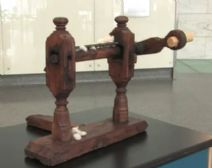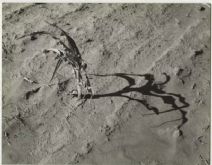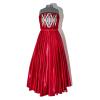As COVID-19 deaths spiked in 2020, Suzanne Firstenberg’s public art installation "In America: How could this happen…"
Agriculture History
Examine collections of the Museum's key resources on major themes in American history and social studies teaching. Additional resources can be found in the main search areas of the website.
Find resources on farming and agriculture history here.
1880s Agricultural Nation Classroom Activity Guide
Resource Type(s): Primary Sources, Lessons & Activities, Worksheets,
Date Posted: 1/22/2011
In this set of classroom activities developed for the exhibition America on the Move, students will use visual, analytical, and interpretive skills to examine primary sources including historical maps to answer questions about farming, transportation, immigration, and racism in the 1880s, and will answer questions about the history and impact of railroads on their own communities. The activities provide opportunities for historical analysis, interpretation, evaluation, analyzing cause/effect relationships, understanding multiple points of view, performing original research, debating and persuasive writing and help students develop and strengthen map-reading skills and the ability to identify issues and problems in the past and connect the past to the present.
American Enterprise: Farming Challenge
Resource Type(s): Interactives & Media,
Date Posted: 3/1/2016
Do you have what it takes to be a farmer? Climb into the cab of a tractor, pick a crop, and make informed decisions about how to manage your farm.
American Enterprise: Globalization and Food
Resource Type(s): Interactives & Media,
Date Posted: 3/1/2016
Spend time exploring Globalization and Food, two topics from the Global Era.
American Enterprise: The Corporate Era, 1860s–1930s
Resource Type(s): Reference Materials,
Date Posted: 3/1/2016
How does American business affect you? How and why has it changed since the United States began? Come explore stories of business men and women who have changed the world. See hundreds of intriguing objects that illustrate transformations in society. Think about how Americans have mixed capitalism and democracy, in an effort to balance individual opportunity and the common good.
During the tumultuous Corporate Era, America became an urban nation. Business got big. While the gap between the rich and poor grew, the growing middle class earned and consumed more.
American Enterprise: Tough Business Decisions
Resource Type(s): Interactives & Media,
Date Posted: 3/1/2016
Companies often face complex ethical business dilemmas. Explore out six fictional scenarios to see how you would respond to a challenging business situation.
American Enterprise: Triple Bottom Line
Resource Type(s): Interactives & Media,
Date Posted: 3/1/2016
As the owner of a new cat food company, you will need to make tough choices to manage the triple bottom line: the balance between people, profit, and planet that will make your business a success.
Cotton Gin Video
Resource Type(s): Primary Sources, Interactives & Media,
Duration: 1 Minutes
Date Posted: 5/15/2012
In this video, students will see both long-staple and short-staple cotton fibers processed in a roller gin and saw gin model similar to that patented by Eli Whitney, to better understand the impact of the cotton gin on cotton production in the U.S. Short staple cotton, with short fibers that stick to the seeds inside, was the type of cotton grown in most of the American south. This video does not include sound, but can be used with the Lemelson Center for the Study of Invention and Innovation resource packet or this Learning Lab Collection.
Dust Bowl Stories
Resource Type(s): Interactives & Media, Lessons & Activities,
Date Posted: 8/31/2012
Discuss the story of the Dust Bowl through images from photographer Arthur Rothstein, through song with Woody Guthrie's Dust Bowl ballads, and through text writings from President Roosevelt and farmer Caroline Henderson. Then, challenge students to consider modern environmental issues with a discussion of the 2012 drought and research on contemporary environmental issues. These lessons are designed to support viewing of the National Youth Summit on the Dust Bowl and can be found in the right sidebar when opening the resource.
FOOD: Transforming the American Table 1950-2000
Resource Type(s): Reference Materials, Interactives & Media,
Date Posted: 4/9/2014
Whether convenient, fast, organic, processed, gourmet, ethnic, or local—the foods available to Americans have never been more plentiful and diverse, or more ripe for discussion. Coupled with big changes in who does the cooking, where meals are consumed, and what we know (or think we know) about what’s good for us, the story of Americans and food in the last half of the twentieth century is about much more than what’s for dinner.
This exhibition at the Smithsonian’s National Museum of American History explores those changes and some of the factors—new technologies, influential people, and broad shifts in social and cultural life—behind them.
History Explorer Podcast: The Bracero Program
Resource Type(s): Interactives & Media, Worksheets,
Duration: 13 Minutes
Date Posted: 10/11/2012
During World War II, America began its largest experiment with guest Labor, The Mexican Farm Labor Program. Commonly called the bracero program, this little known chapter of American and Mexican history touched the lives of countless men, women, families, and communities. Learn about the bracero program and the Smithsonian’s initiative to document it with curator Stephen Velasquez. The resource set includes a teacher guide and student worksheet.
Model Plow
Resource Type(s): Artifacts,
Date Posted: 4/4/2016
This single reversible right and left plow model is part of a large collection of model plows that were transferred from the Department of the Interior to the U.S. National Museum in 1910. In 1952, curator Edward C. Kendall researched the model plows and desired to catalog and identify the typology of the hundreds of models, and his research led him to believe the models were made in Germany. Through correspondence with Kendall, Professor W.E. Fishcher Schlemm of the Royal Agricultural College in Stuttgart Hohenheim confirms that the models at the Smithsonian were made at a model factory previously connected with the college. Fischer Schlemm believed that Ludwig von Rau was in charge of having the models made when he worked at the school from 1852 until 1872. Fischer Schlemm said he owned a list of the models with their country of origin, which curator Kendall was keenly seeking. The list is not in the file, perhaps it exists elsewhere.
National Youth Summit: Dust Bowl
Resource Type(s): Interactives & Media,
Date Posted: 10/17/2012
In this archived webcast related to Ken Burns’s film The Dust Bowl, thousands of high school students joined in a national dialogue regarding the Dust Bowl’s legacy on both the environment and the culture of the United States. Students discussed the importance of environmental awareness and the effects humans have on the natural world. In recognizing the Dust Bowl as an ecological disaster of primarily human origin, young people worked together to imagine ways a similar catastrophe could be avoided. Together, students across the country generated ideas for how each of us could be a responsible steward of the delicate environment in which we live. The National Museum of American History (NMAH) partnered with the National Endowment for the Humanities, WETA television, and Smithsonian Affiliations to present the National Youth Summit on the Dust Bowl.
Wooden Grain Pitchfork
Resource Type(s): Artifacts,
Date Posted: 4/4/2016
This wooden grain fork was used during the late 19th century. Wide tined pitch forks like this were used to pitch hay, grains, straw, and other agricultural products. Before the mechanization of harvesting by combines, reaping, threshing, and winnowing were done by hand with simple tools like this wooden pitchfork.

























